Comprehensive Guide to Mackiteboarding Techniques and Gear
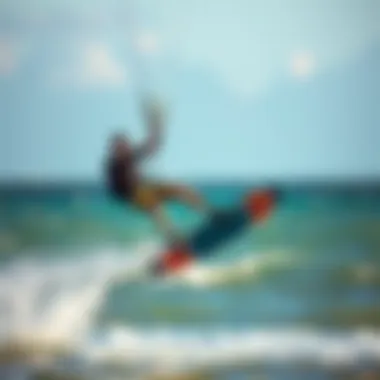
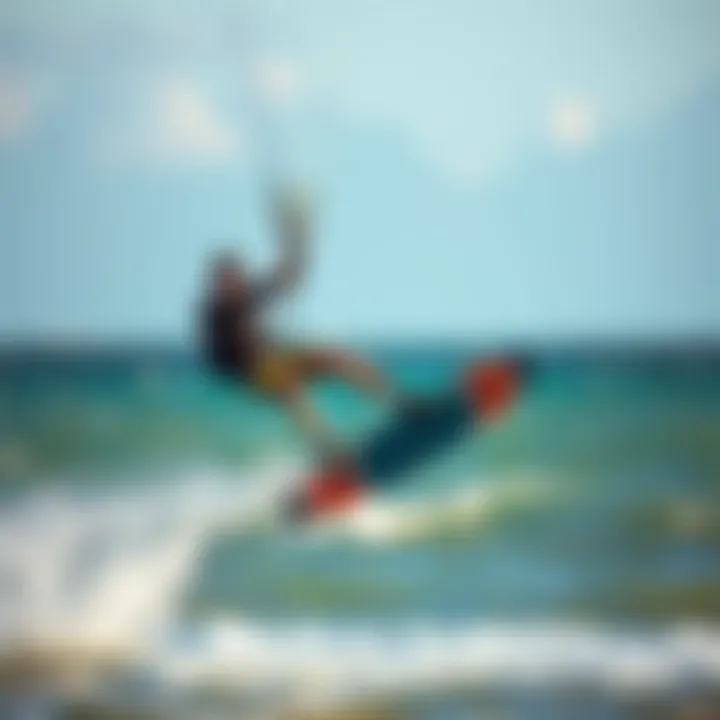
Intro
Kiteboarding, often referred to as Mackiteboarding in some circles, is more than mere sport; it’s a lifestyle cloaked in adventure. Rising from the shores of beaches, this rapidly growing activity offers a blend of adrenaline and serenity—it’s about catching the wind just right and gliding atop the waves gracefully. In this guide, we’re diving deep into the world of Mackiteboarding. You'll find insights not just about the techniques, but also the gear that makes it all happen, the community that surrounds it, and the culture that has blossomed around this exhilarating sport.
This exploration is tailored for everyone—from those dipping their toes in the waters for the first time, to those seasoned riders looking to elevate their skills further. Whether it’s the best places to kiteboard or the nitty-gritty of safety protocols, we aim to cater to all who are passionate about kiteboarding.
Expect to learn about the foundational principles that underpin the sport, discover advanced methodologies, and gain an appreciation for the rich community fabric that binds kiteboarders together. So, grab your gear and prepare for an exciting journey into the depths of Mackiteboarding.
Gear and Equipment
Proper gear is vital for any successful kiteboarding experience. Understanding what you need is half the battle won.
Essential Kiteboarding Gear for Beginners
If you're just starting out, it may feel like a big step. But, here is what you actually need:
- Kite: The heart of the sport. Look for beginner-friendly kites; they are more stable and easier to control.
- Board: A twin-tip board is typically best for beginners since it allows you to ride in both directions.
- Harness: Choose a comfortable harness, as it connects you to the kite. Waist harnesses are popular but seat harnesses also work well.
- Safety Gear: A helmet and impact vest can save you from nasty falls. Safety first!
- Leash and Control Bar: Essential for steering your kite and ensuring you are connected in case things go awry.
Advanced Equipment for Experienced Riders
For those more seasoned in the sport, it’s time to upgrade your gear for enhanced performance:
- High-Performance Kites: Opt for specialized kites that cater to specific conditions, such as light wind or freestyle.
- Advanced Boards: Choices vary from directional boards to hydrofoils, depending on your preferred riding style.
- Customizable Harnesses: Allow for better fit and functionality—some even come with integrated back protection.
- Additional Safety Gear: Reflective gear and advanced flotation devices can be considered as you push your limits.
"Good equipment can make a world of difference. It's worth investing in quality gear to truly enjoy the ride."
Techniques and Tips
Once you've got the right gear, you need to master your techniques to truly harness the wind and waves.
Basic Riding Techniques for Newbies
Getting your feet wet—figuratively and literally—starts here:
- Body Dragging: This is a crucial first step to learn how to control the kite while being in the water.
- Water Starts: Practice getting up on your board from the water. It’s tricky, but persistence pays off.
- Riding Upwind: Once you can get up on your board, learning to ride upwind will help you avoid long walks back.
Expert Tricks to Elevate Your Skills
When you're feeling comfortable on the board, it’s time for fun tricks:
- Jumps and Air Tricks: Gradually work your way up to small jumps before trying for higher air. Control and technique are key.
- Transitions: Reversing directions smoothly while riding can impress your friends and make your riding more enjoyable.
- Freestyle Techniques: Explore more advanced tricks that can make your sessions exciting and eye-catching.
It's essential to keep practicing, and maybe find a community where you can share knowledge and skills. Connecting with more experienced kiteboarders can fast-track your progress. Don’t forget to gear up correctly and ride safe.
This guide is just the tip of the iceberg when it comes to Mackiteboarding, but you now have a solid starting point. Let's lace up those boots and hit the winds!
Prolusion to Mackiteboarding
Mackiteboarding is not just a passing trend; it represents a thrilling fusion of skill, adventure, and an appreciation for the great outdoors. This sport plucks inspiration from various watersports, weaving in elements of surfing, windsurfing, and paragliding. But why should one immerse themselves in the world of Mackiteboarding? Well, for starters, it offers unparalleled freedom on the water, allowing riders to glide fluidly across the waves while harnessing the power of the wind.
The essence of Mackiteboarding lies in its ability to connect people with nature. Imagine standing on the beach, feeling the sun warming your skin, the wind whipping through your hair, and the surf crashing against your board. It's a sensory experience, an escape from the mundane, and even a source of community. Kiteboarding enthusiasts, regardless of skill level, share a mutual respect for the sport. They rally together in a shared pursuit of mastery, setting up camps at various beaches or participating in competitions.
Why Focus on Mackiteboarding?
The significance of this guide is not just to broaden your knowledge but to transform how you approach the sport. Here's what you'll discover:
- Foundational Understanding: We delve into the history and evolution of Mackiteboarding, shedding light on its journey and its cultural significance within the watersports community.
- Equipment Insights: Selecting appropriate gear can mean the difference between an exhilarating ride and a frustrating struggle. The guide emphasizes informed choices in kites, boards, and other essential equipment.
- Skill Development: From the novice stage to advanced techniques, learning curves vary widely, yet clear training methods can expedite improvement.
- Cultural Connection: Mackiteboarding is more than a sport; it’s a lifestyle. The people, the destinations, the stories—each contributes to a rich tapestry that defines this community.
- Safety Awareness: In every adventure, safety must remain a priority. This guide details essential safety protocols ranging from understanding weather patterns to emergency preparedness.
Mackiteboarding enables individuals to push their limits while respecting the elements. The thrill of catching an ideal breeze or landing a challenging trick becomes a driving force for many enthusiasts. So, whether you are a complete beginner eager to learn or a seasoned rider looking to refine your skills, understanding these layers of Mackiteboarding is crucial.
As we embark on this journey through the depths of Mackiteboarding, remember that it's not merely about riding the waves but also about embracing a culture rich in connection, challenge, and respect. Welcome aboard.
The Evolution of Mackiteboarding
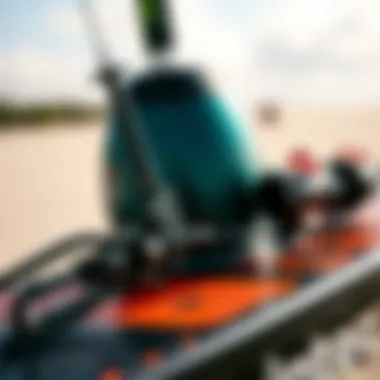
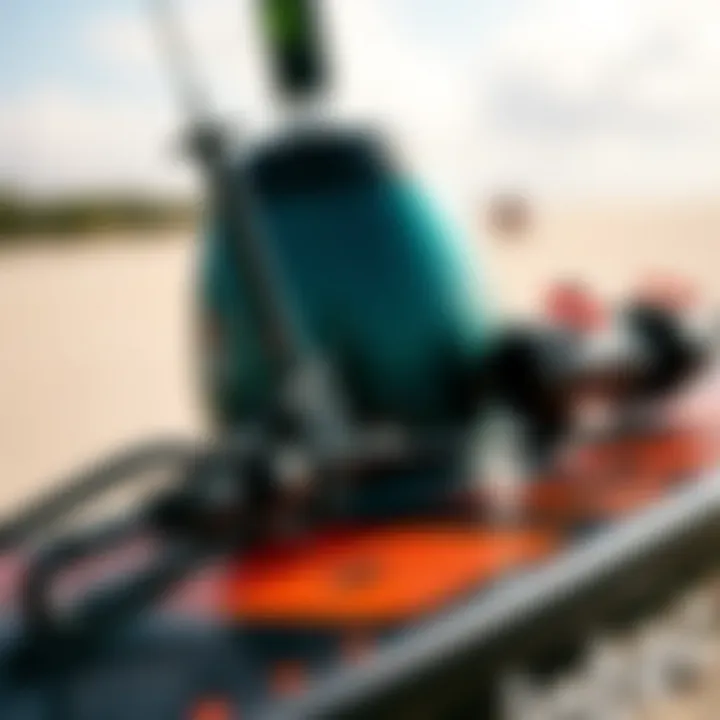
Mackiteboarding has undergone significant transformations since its inception, shaping how enthusiasts approach the sport today. Understanding the evolution of this exciting pastime is crucial, as it reflects not only advancements in technology but also shifts in cultural perspective towards outdoor sports. This journey reveals how the past influences current practices and how community engagement can enhance the experience for both newcomers and seasoned riders. By exploring how Mackiteboarding has developed over the years, we can appreciate the richness of its culture and anticipate future trends.
Historical Overview
The origins of Mackiteboarding can be traced back to traditional kites used for transportation and water sports. The playful interaction between kites and water began to gain traction in the late 1990s. Early enthusiasts experimented with combining kites and surfboards, leading to the birth of what we recognize today as Mackiteboarding. These early adapters—often viewed as rebels of their time—turned open ocean waves into playgrounds, testing the boundaries of their gear and skills.
Key locations, such as Hawaii and the Caribbean, emerged as foundational spots for the sport, providing not just suitable winds and waves but also a vibrant community atmosphere. It was amidst these beautiful backdrops that the initial toolkit for Mackiteboarding was born. Innovations like the first inflatable kites and improved control systems marked revolutionary changes in how kiteboarders interacted with the wind.
Moreover, crossover techniques from surfing and windsurfing were introduced, further enriching rider skills and styles. As the sport matured, it began to shed its grassroots image and attracted interest from a wider audience, paving the way for commercial development and increased safety equipment standards.
Key Milestones in the Sport
Several milestones stand out in the history of Mackiteboarding, each marking a turning point that dramatically improved not only the equipment but also the safety and accessibility of the sport. Here are a few pivotal moments:
- 1999-2000: The introduction of the first widespread inflatable kites, which made the sport safer and more approachable for beginners.
- 2000: The first official Mackiteboarding World Championship showcased talent from around the globe, igniting international interest and competition.
- 2005: Kiteboarding was recognized as an official sport in the International Kiteboarding Association (IKA), solidifying its status in the realm of competitive watersports.
- 2010s: The rise of social media platforms provided a new avenue for sharing experiences and fostering communities, greatly influencing the sport’s growth. The advent of video tutorials and instructional content democratized learning, allowing anyone to take up the sport.
- 2020 and beyond: With sustainability in mind, new materials and eco-friendly practices began to emerge, as riders and manufacturers alike recognized the importance of protecting the environments in which they play. This shift not only improves the perception of the sport but also attracts environmentally conscious individuals to join the kiteboarding community.
Overall, the journey of Mackiteboarding from its humble beginnings to a major player in the watersport scene highlights the dynamic interplay between innovation, community, and culture. The evolution of Mackiteboarding is a testament to human creativity and resilience—qualities that continue to propel the sport into new heights and deeper waters.
Essential Equipment for Mackiteboarding
When it comes to mastering the waves and the wind, having the right gear is non-negotiable. Equipment functions not just as a tool, but as an extension of your body while kiteboarding. Your performance, safety, and overall experience rely on the various components that make up your kiteboarding setup. In this section, we’ll break down the essential pieces of gear you need.
Kites: Types and Selection
Choosing the right kite can make or break your ride. There are mainly three types of kites: bow kites, delta kites, and C-kites. Each type serves a purpose, depending on your skill level, conditions, and style.
- Bow Kites: Great for beginners, these kites provide a wide wind range and stability. They can also be depowered easily, allowing for safer rides in tricky conditions.
- Delta Kites: These are versatile and forgiving, making them suitable for all skill levels. They adapt well to changes in wind direction and are ideal for light wind conditions.
- C-Kites: Favored by advanced riders, these kites deliver high performance with excellent control during jumps. They can be a bit tricky for beginners but are beloved for their speed and agility.
When selecting a kite, consider the size and wind conditions in your area. A larger kite works better in light winds, while a smaller kite excels in strong winds. Additionally, the material and build quality affect durability and performance. Always try before you buy if possible, and consult with seasoned kiteboarders or local shops for their recommendations.
Boards: Styles and Features
Just like kites, the right board can drastically improve your riding experience. Board shapes vary, and each one has its unique characteristics. Here are some design styles you might encounter:
- Twin Tip Boards: These are the most common among freestyle and freeride kiteboarders. They are symmetrical, allowing for easy riding in both directions.
- Directional Boards: Typically used for surfing in the waves, these boards require a specific stance and focus more on carving than jumping.
- Foil Boards: A rising trend, foil boards lift out of the water on a hydrofoil, allowing for smooth gliding and extended sessions in lighter winds.
When choosing a board, consider the sort of riding you plan to do. A wider board offers better stability while a narrower one promotes speed. Look into the flex of the board too; stiffer boards are better for aggressive riding, while softer boards offer more comfort in chop.
Safety Gear: Necessities and Recommendations
Safety should be your top priority—always! Having the right safety gear can significantly reduce risks while kiteboarding. Here are the essentials:
- Harness: There are two types—seat and waist harnesses. A seat harness provides more support, especially for beginners, while a waist harness offers a greater range of motion for tricks.
- Impact Vest: Protects your torso from impacts, especially during jumps and falls. It’s lightweight and can save you from painful injuries.
- Helmet: To shield your noggin from impacts, a helmet is a must. Choose one designed specifically for kiteboarding, which allows for good visibility and ventilation.
- Safety Leash: This connects you to your kite and allows for quick release in emergency situations.
For additional protection, consider wearing wetsuits or drysuits depending on the water temperature, as these can prevent hypothermia and offer extra buoyancy if you fall. In summary, investing in quality equipment not only enhances your experience but boosts your confidence when tackling the elements.
"A well-prepared kiteboarder is a happy kiteboarder. Gear selection can dictate the vibe of your ride to no ends!"
By arming yourself with the proper equipment, you can focus on honing your skills and enjoying the thrill of Mackiteboarding, knowing you have what you need for safety and performance.
Techniques and Training
The realm of Mackiteboarding is vast, stretching beyond just the thrill of gliding over water. It's an intricate dance of skill, technique, and an understanding of various environmental factors. Mastering these aspects isn't just beneficial; it's crucial for ensuring a safe and enjoyable experience. Techniques and training form the bedrock upon which a kiteboarder's prowess is built. They impact not only personal performance but also contribute to the overall culture of the sport and community. Whether you're a fledgling kiteboarder or a seasoned pro, investing time in mastering the right techniques can elevate your sessions.
Fundamentals for Beginners
Embarking on your Mackiteboarding journey may seem daunting, but cracking the basic fundamentals will pave the way for more advanced skills later. Here are some key areas beginners should focus on:
- Body Positioning: Achieving the right stance is essential. Functions involving your knees, hips, and core strength play a significant role. A balanced position helps maneuver effectively and absorb any impacts.
- Kite Control: Understanding the kite's flight pattern is paramount. Beginners should spend time practicing on land, learning how to launch, land, and steer the kite before hitting the water. It’s like learning to ride a bike without training wheels - once you get the hang of it, the freedom it brings is exhilarating!
- Safety Measures: Learning to self-rescue and being aware of the kite's behavior in different wind conditions can't be overlooked. This knowledge not only keeps you safe but also grants peace of mind while learning.
"Understanding the kite's behavior is half the battle, but safety is the ultimate victory."
Advanced Maneuvers for Experienced Riders

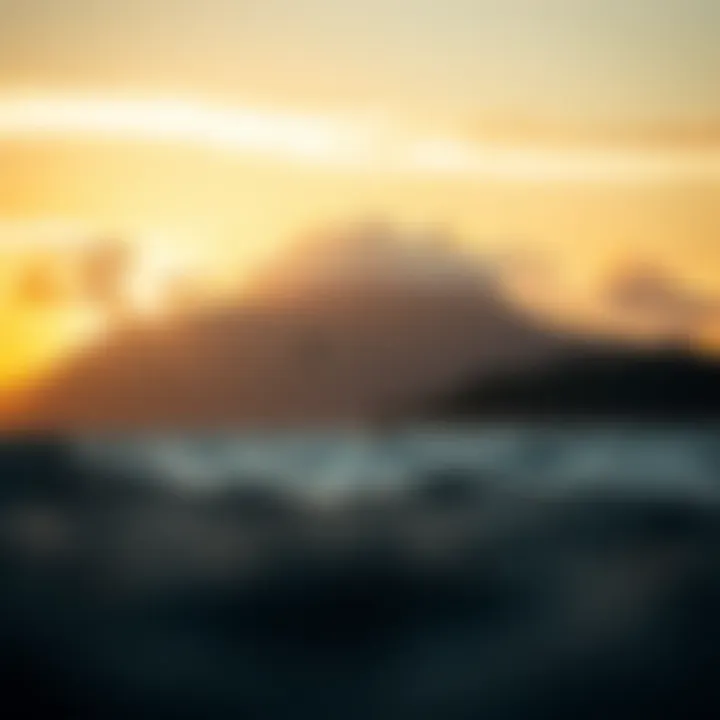
For those who have already grasped the fundamentals and are riding confidently, it’s time to explore the horizon of advanced maneuvers. These skills require a certain finesse and understanding of the dynamics involved in kiteboarding. Here are some maneuvers to consider:
- Jumping: This is often considered the holy grail for many. Mastering jumping involves timing, kite control, and proper edging. Once you can leap over waves with grace, the feeling cannot be matched.
- Wakestyle Tricks: Incorporating elements like grabs and spins requires precision in your movements. Riders often spend years perfecting combinations of these to express style on the water.
- Downwinders: Long-distance rides require an understanding of wind patterns and stamina. These sessions challenge kiteboarders to adapt their techniques based on the changing environment.
Common Mistakes and How to Avoid Them
Every kiteboarder, no matter how experienced, has faced bloopers along their journey. Acknowledging these common pitfalls and strategizing on how to sidestep them is vital:
- Ignoring Wind Conditions: Always check weather reports before heading out. Ignorance here can lead to dangerous situations. Using apps like Windy or Windguru guides your decisions.
- Neglecting Equipment Checks: Regularly inspecting your gear for wear and tear is critical. A small tear in your kite or a frayed line can turn into a major mishap.
- Overconfidence: It’s easy to let your abilities get ahead of your current skills. Practicing humility and respecting the ocean not only keeps you safe but also teaches valuable lessons.
For more information on techniques and proper training regimens, check out resources like Kiteboarding.org and Wikipedia's kiteboarding page.
Always remember that practice, patience, and respect for the water will lead to an unforgettable kiteboarding journey.
Best Destinations for Mackiteboarding
Mackiteboarding, a sport that blends the thrill of surfing with the aerial acrobatics of kite flying, is more than just a pastime; it’s a culture that thrives in the heart of communities across the globe. Selecting the best destinations for this exhilarating activity is vital. The right location can elevate the experience, offering ideal wind conditions, beautiful scenery, and a welcoming atmosphere for both seasoned pros and newcomers. Each spot tells its own story, providing unique challenges, stunning vistas, and a chance to connect with fellow enthusiasts.
Moreover, understanding the topography and climate of each destination allows kiteboarders to optimize their time on the water, mastering their skills while enjoying the beauty of nature. Let's dive into the specifics of the best locations around the world.
Top Locations Worldwide
When one thinks about prime kiteboarding spots, several renowned locations spring to mind. Here’s a closer look at some of the top places reputed for their exceptional wind and water conditions:
- Tarifa, Spain: Often dubbed the wind capital of Europe, Tarifa strikes a perfect balance between wind consistency and a vibrant kiting community. The mix of the Mediterranean and Atlantic seas provides a diverse experience, catering to all skill levels.
- Cape Town, South Africa: With its jaw-dropping Table Mountain as a backdrop, Cape Town offers exhilarating conditions. The summer months bring consistent winds and warm waters, making it a must-visit for kiteboarders trying to catch the waves and savor the incredible landscapes.
- Maui, Hawaii: Known for its impeccable conditions, Maui’s Hookipa Beach is famous for its wind and waves. The stunning natural beauty, combined with the warm climate year-round, makes this a paradise for those looking to enhance their kiteboarding prowess.
- The Bahamas: With its crystal-clear waters and vast sandy beaches, the Bahamian islands, particularly Eleuthera, provide a tranquil escape for kiteboarders. The flat, shallow waters are perfect for beginners, while more experienced riders find challenges among the waves.
- Brazil: The northeast region, especially Jericoacoara and Cumbuco, is a kiter’s dream. Known for its reliable trade winds, these beaches host numerous kiteboarding competitions and festivals, creating an atmosphere that’s both competitive and celebrative.
Hidden Gems for Kiteboarders
While well-known destinations offer great experiences, hidden gems can lead to unforgettable adventures away from the crowds. These spots often boast undisturbed nature and unique local cultures:
- Kite Beach, Zanzibar: This sub-tropical paradise not only features stunning landscapes but also consistent winds ideal for the sport. The local culture adds charm, making it an enriching experience for those who venture here.
- Phan Rang, Vietnam: Less crowded than other kiteboarding hotspots, Phan Rang offers long stretches of flat water, consistent winds, and warm temperatures. The serene environment allows riders to progress without feeling rushed or overwhelmed.
- Isla Blanca, Mexico: Located just north of Cancun, Isla Blanca is becoming increasingly popular among kiteboarders. Its shallow, flat waters are excellent for beginners, while the warm breezes provide an inviting atmosphere for all.
- Fuerteventura, Canary Islands: Sometimes overshadowed by its sister islands, Fuerteventura has excellent wind conditions, powdery sands, and a lower tourist influx. The island is ideal for kiteboarders looking for a more laid-back environment while still enjoying quality conditions.
- Dakhla, Morocco: This location is a dream for many kiteboarders thanks to its unique lagoon system. The steady winds and stunning landscapes, combined with the local hospitality, create a vibe that’s both exhilarating and welcoming.
These destinations represent just a fraction of the many places around the world where kiteboarding can thrive. The diversity of each location offers something special, whether it be culture, environment, or technique, catering to the different tastes and skills within the kiteboarding community.
Safety Protocols and Best Practices
In the exhilarating realm of Mackiteboarding, safety is not just a guideline; it's a necessity. A fly-by-the-seat-of-your-pants attitude can lead to perilous situations that no rider wants to encounter. From the novice who has just stepped onto a board to the seasoned expert soaring through tricks, understanding and implementing safety protocols can make the difference between a thrilling session and a disastrous day at sea. A focus on safety is essential not just for personal well-being, but for fostering a secure environment for all kiteboarders.
Understanding Weather Conditions
Before unpacking your gear, it’s crucial to know what nature has in store. Weather plays a significant role in kiteboarding, and a calm day can quickly turn into a challenging experience. The wind is your friend, but it can also be a foe. Familiarize yourself with wind speeds and weather patterns. For instance:
- Ideal Wind Speeds: Kites typically fly best between 12 to 25 knots. Higher winds can make control difficult, especially for beginners.
- Storm Warnings: Pay attention to shifts in weather. Dark clouds and sudden gusts may indicate an approaching storm, so always check local weather forecasts before heading out.
- Local Knowledge: Engage with local kiteboarding communities to understand the microclimates that may impact your session. Certain beaches can be windier or receive chop thanks to the geography.
Keeping an eye out for sudden weather changes is imperative. If the wind conditions are not safe or are above your skill level, it's better to stay on land. As a common saying goes, “It’s better to be safe than sorry.”
Emergency Procedures
Despite the best precautions, lurking dangers can throw a wrench in your plans. Being prepared with a clear set of emergency procedures can save lives and reduce panic in difficult situations. Here are vital points to consider:
- Know Your Rescues: Identify the methods to self-rescue or get assistance from fellow riders. Master the technique of controlling your kite with one hand while detaching your harness.
- Equipment Familiarity: Practice using your safety release mechanisms well before you hit the water. If you find yourself in a tough spot, being accustomed to your gear can make a critical difference.
- Emergency Contacts: Always have a plan in place for emergencies. Store important contacts in your phone, and inform at least one person onshore of your riding plans and expected return time.
Keeping your wits about you means the difference between enjoying a ride and facing hazards.
In the event of an unexpected fall or equipment failure, don’t panic. Assess your surroundings. If you are unable to return to shore due to equipment failure, signal for help using hands or your board as a flag. Familiarize yourself with local rescue protocols — know whom to call or signal.
Safety in Mackiteboarding is paramount. Understanding the weather and having clear emergency procedures can make cycling through unpredictable conditions much smoother and safer. Prioritizing these elements will set the stage for not only a thrilling experience but a secure one.
Cultural Aspects of Mackiteboarding
The cultural aspects of Mackiteboarding extend far beyond the act of riding the waves with a kite. It's a subculture that fosters community, camaraderie, and a shared passion for not just the sport, but the lifestyles that come with it. This section aims to explore how Mackiteboarding has developed into a vibrant tapestry of social interactions, events, and travel experiences that shape the lives of its practitioners.
Community and Events
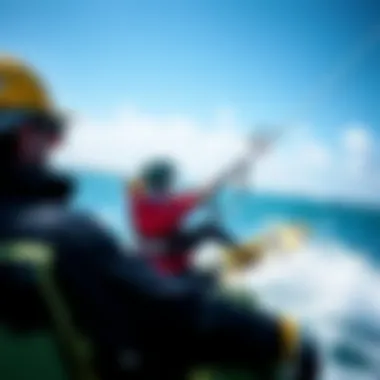
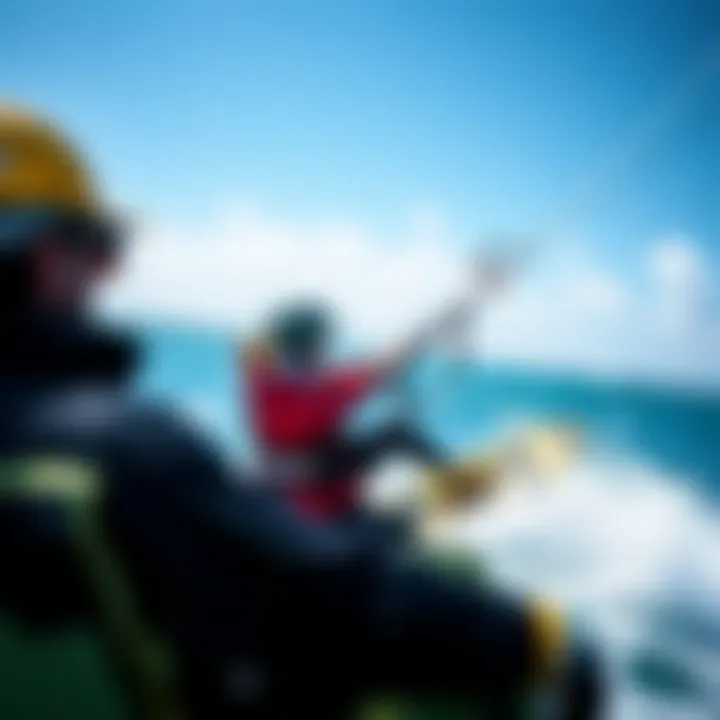
Mackiteboarding creates a buzz among enthusiasts, leading to a tightly-knit community that thrives on interaction. Local clubs, online forums, and social media platforms become gathering places where riders exchange tips, share personal stories, and organize meet-ups. Events like competitions, clinics, festivals, and retreats enhance this sense of belonging.
Local competitions help people gauge their skills, witness impressive maneuvers, and, perhaps most importantly, support one another. For seasoned riders, it's an opportunity to showcase their talents. For newcomers, it's a safe space to learn and grow.
Big festivals, such as the Mackiteboarding Festival in Cape Hatteras, offer fun activities where families can attend, enjoy food trucks, meet industry leaders, and participate in hands-on workshops. These gatherings not only boost skills but also lay the groundwork for lasting friendships.
Some key events to watch out for include:
- Kitesurf World Cup in Germany
- King of the Air in South Africa
- Kiteboard Tour Asia
Moreover, engaging in community-driven volunteer events solidifies bonds, such as beach clean-ups for eco-friendly kiteboarding. Taking care of the environment rounds out the experience. It shows that Mackiteboarding is not just a sport, but a lifestyle committed to preserving the very playgrounds where it takes place.
"It's not just about kites and boards; it's about the people you meet along the way", says a seasoned kiteboarder from California.
Influences on Lifestyle and Travel
Mackiteboarding has a ripple effect on lifestyle choices and travel plans for many enthusiasts. As riders become entranced by the sport, it influences where they want to live, how they choose to spend their vacations, and even the friends they make. The connection to water, wind, and adventure ignites a desire to seek out the best spots globally.
Many kiteboarders often plan trips to coastal destinations renowned for their wind conditions and wave quality. Spots like Tarifa in Spain and Cabarete in the Dominican Republic become go-to locales for those chasing the thrill of kiteboarding, transforming a simple holiday into an adventurous odyssey.
Notably, travel extends beyond mere escapism; it becomes a means of self-discovery and personal growth. Navigating foreign lands, meeting new folks, and tackling various kiteboarding conditions contribute to enriching life experiences.
For seasoned riders and beginners alike, the journey doesn't always revolve around the sport. It's also an escape from the daily grind, offering freedom, mental clarity, and a sense of purpose. Many enthusiasts find themselves chasing the wind not just for the adrenaline but for the peace it brings and the unique perspectives gained through travel.
In summary, the cultural aspects of Mackiteboarding form an enduring narrative that intertwines community, events, and lifestyle shifts. These dimensions not only enhance the overall experience of kiteboarding but also enable a deeper connection to the environment and fellow enthusiasts.
The Future of Mackiteboarding
The realm of Mackiteboarding is in constant motion, much like the wind that fills the kites. Understanding the future of this thrilling sport is essential for riders at all levels. Not only does it prepare participants for upcoming trends, but it also ensures that the sport remains accessible, exciting, and environmentally conscious. With an infusion of technology and a push towards sustainability, the horizon of Mackiteboarding looks vibrant and full of potential. Recognizing how these elements intertwine can help foster a deeper appreciation for this activity and its community.
Technological Advances and Trends
As we stride into the future, technology plays a pivotal role in transforming Mackiteboarding. The developments in materials for kites and boards have made them lighter, sturdier, and more responsive. Modern equipment allows riders to harness wind in ways that were once unimaginable.
- Smart Kites: Several companies are pioneering kites equipped with sensors that provide instant feedback about wind conditions and rider performance. These innovations can help both novices learn the ropes quicker and advanced riders fine-tune their skills.
- Electric Foils: A huge trend in the sport is the rise of electric foiling. Riders can now glide over water without wind, broadening the time and places one can kiteboard. This technology is rapidly improving, with batteries becoming lighter and providing longer run times.
- Wearable Tech: Devices that monitor heart rates, G-force, and even GPS tracking are becoming increasingly popular among kiteboarders who want to understand their performance metrics better.
These advancements help not just in enhancing the thrill-factor but ensure a degree of safety that wasn't available in earlier years. As the sport continues to grow, the integration of AI and IoT in equipment will likely lead to more personalized experiences for kiteboarders.
"Technology isn't just enhancing Mackiteboarding; it's redefining it. Each new innovation opens doors for creativity and performance that we couldn't dream of just decades ago."
Sustainability in the Sport
With growing awareness about environmental issues, the future of Mackiteboarding is also veering towards sustainability. As kitesurfers and outdoor enthusiasts, responsibility towards nature is becoming a priority. Several initiatives are emerging that aim to preserve our oceans and landscapes:
- Eco-Friendly Materials: Manufacturers are exploring the use of recycled materials in kite and board production. Kites made from sustainable sources reduce environmental impact without compromising quality.
- Cleanup Campaigns: Various kiteboarding communities around the world are orchestrating outings where participants clean local beaches and waterways. This collaborative effort is raising awareness about the importance of maintaining clean coastal and waterway environments.
- Education Programs: Some industry leaders are engaging in projects to educate both present and future kiteboarders on the environmental impact of their sport, promoting responsible riding practices.
As the sport progresses, the call for sustainable practices will only intensify. Embracing an eco-conscious approach not only safeguards the beautiful locations we ride but also fortifies the community spirit. By focusing on sustainability, riders can ensure that future generations enjoy the wind and waves just as they do today.
Epilogue
In wrapping up our exploration of Mackiteboarding, it is crucial to emphasize the significance of this dynamic sport. For both beginners and experienced riders, understanding the multifaceted aspects of kiteboarding merges excitement with responsibility. The sport is not only about gliding over open waters and catching the wind; it plays a vital role in shaping communities and enhancing personal skills.
One of the key elements highlighted throughout this guide is the importance of safety protocols. Kiteboarding can be thrilling, but working knowledge of weather conditions and emergency procedures ensures that such thrills do not veer into dangerous territory. Equipping oneself with the proper safety gear is not just a recommendation; it's a necessity. Riders must remain vigilant about the environment and their equipment, which can mitigate risks significantly.
Furthermore, the article shines a light on techniques and training that elevate one’s ability. Mastering the fundamentals is foundational, yet aspiring kiteboarders should also think ahead to the more advanced maneuvers. Gaining proficiency in these areas not only amps up the fun factor but also opens doors to more complex riding styles and competitions.
With the cultural aspects of kiteboarding embedded within its fabric, the sense of community is palpable. Events and local gatherings provide networking opportunities, allowing kiteboarders to share tips, look for gear, and engage in friendly banter. It's this camaraderie that keeps the sport vibrant and continuously growing. From connecting with fellow enthusiasts to participating in community events, one absorbs a culture rich with passion and adventure.
As noted in the section about the future of Mackiteboarding, the integration of technology and sustainability practices represents an ongoing evolution in the sport. Staying informed about innovations in gear and eco-friendly practices can enhance not only riding experience but also the overall health of the environment where kitesurfers thrive.
In summary, this guide serves as a vital tool in navigating the thrilling waters of Mackiteboarding. By understanding essential techniques, embracing safety practices, and engaging in the community, riders can enhance their enjoyment of the sport and contribute positively to its future. Always remember the wind beneath your wings, or in this case, your kite!
"Knowledge coupled with action is the pathway to mastery in any sport."
Resources for Further Exploration:
- Wikipedia on Kitesurfing
- Britannica Entry on Kites
- Reddit Community Discussions
- The Kiteboarding School
- National Weather Service
These resources provide deeper insights into both the technical and community aspects of Mackiteboarding. Whether you're just starting out or are a seasoned pro, continuing to learn and connect within the kiteboarding community is key to a fulfilling experience.















